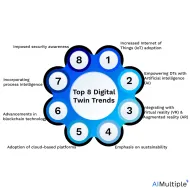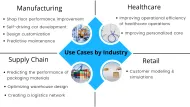The global digital twin market size is estimated to reach $73.5 billion by 2027. 1 Digital twin of an organization (DTO) is a newer application of digital twin technology, aiming to capture how a business functions in real time. DTOs are built to analyze an organization’s processes or services in a virtual environment to run simulations and address issues which may confronted the business in real-life situations.
Explore what is a digital twin of an organization, how does it work, how is it different to process simulation, process mining and task mining and top DTO providers:
Check out for more details on digital twins and digital twin applications.
What is a digital twin of an organization?
A digital twin of an organization (DTO) is a virtual model of a physical process, product, or service, which includes data about:
- Previous performance
- Business goals
- Business models
- Business processes
- Performance KPI indicators with target levels
- Detailed transaction-level situational process analysis
To optimize performance, DTO models require consistent updates about the organization’s functioning, resource utilization, product quality, and meeting customer needs.
Explore DTO use cases in detail.
3 Benefits of leveraging a digital twin of an organization
Unlike traditional digital twins focused on machines or products, a DTO models how an entire business operates, helping leaders test and refine processes digitally before making changes in the real world. DTOs enable the dynamic virtual representation of an organization in its operational context, which provides:
- Digital representation of employees, processes, data, and assets as they exist in the physical world, which enables:
- Enhanced coordination among employees in an organization
- Identification of an organization’s inefficiencies or weakness
- Platform to train employees on work operations and new practices
- Predictive analyses about:
- outcomes of changes in process, product, or service
- risks and costs of adopting new processes or leveraging new technologies
Digital twin of an organization software vendors
DTO software is still an emerging technology in the market compared to digital twin technology. However, some companies are providing DTO software to analyze business processes, monitor and predict the future evolution of processes. Here’s a list of DTO vendors:
| Company | DTO Platform | Founded | Number of employees | Out of the box integrations |
|---|---|---|---|---|
| Arrayworks Inc. | Transformation Acceleration Platform (TAP) | 2000 | 11-50 | N/A |
| MAVIM | MAVIM DTO | 1990 | 51-200 | Microsoft products |
| myInvenio | My Invenio DTO | 2013 | 11-50 | Microsoft |
| Ortelius | Inorigo® | 2000 | 11-50 | Microsoft Azure |
You can check out our data-driven DTO vendors list for more.
Digital twin of an organization vs. process mining and task mining
DTO tools differ from task and process mining by enabling full-scale organizational simulation rather than focusing solely on event logs or user interactions.
However, users should keep in mind that DTO, process mining and task mining are all emerging fields. Therefore, these fields are not too well defined and overlapping in terms of the benefits that they provide.
Process simulation vs. DTOs
Process simulation is a digital representation of real-life processes and systems, such as customer support centers or manufacturing facilities. It has been applied to designing, developing, analyzing and optimizing processes in manufacturing, chemistry, education, finance & sales.
Process simulation software allows users to consider every component, test them, and refine them by establishing an accurate virtual environment. As a result, business analysts can investigate and develop optimal processes without interrupting their daily operations.
DTOs extend beyond traditional process simulation by linking process behavior with organizational context, allowing broader scenario analysis and experimentation. The vendors use two different concepts for process simulation because they want to highlight that digital twins are dynamic virtual representations, relying on actual process data rather than static visuals based on historical data.
However, we find the difference between the two concepts blurring since the process simulation vendors continue to add capabilities to their solutions so that the software can leverage real-time process data and generate dynamic models.
process mining and task mining vs DTOs
Process mining starts from event data. Input for process mining is an event log. An event log views a process from a particular angle. Each event in the log refers to:
- a particular process instance (called case)
- an activity
- a timestamp
There may be additional event attributes referring to resources, people, costs, etc., but these are optional.
Process mining transforms this data into an event log, and then creates visualizations of the end-to-end process, along with insightful analyses. Thus, process mining uses these event data to answer a variety of process-related questions.
Process mining software can be used in:
- Process discovery to enable process automation.
- Process discovery to enable decision automation.
- Process optimization
- Conformance validation
- Process simulation
- Organizational mining
To learn more about process mining software, feel free to read our data-driven list of vendors and market place.
Task mining examines how employees interact with their computers to complete tasks, revealing patterns and inefficiencies at the individual task level. It uses technologies like screen recording, event logging, and AI to identify inefficiencies and optimize processes at the task level.
DTOs represent a high-resolution digital copy of a process model, using current business data to show how an organization is running in near real-time. This allows businesses to test changes in a virtual model before implementing them in the real process, providing a quick and risk-free way to identify the best process improvements for market relevance and added value.
How can a digital twin of an organization leverage process mining?
DTOs are built with process data and understanding. Therefore, they rely on process mining and task mining techniques.
Task Mining
Task mining is a process of collecting data from a step-by-step workflow of the users, using detecting systems they interact with. Task mining works by:
- Capturing desktop data (clicks, scrolls, screenshots)
- Collecting words, numbers, and additional texts on users’ screens using optical character recognition (OCR)
- Cluster actions into meaningful activities, therefore, giving them “labels”.
Task mining then uses an algorithm to automatically generate an event log for tasks within a process activity to derive an end-to-end process of the task.
Business-rule mining
Business-rule mining involves extracting decision logic and operational rules from enterprise data to better understand how processes are governed. This insight allows users to create precise scenarios to simulate later for testing effectiveness.
Simulation
Using the extracted activities and business rules, users can create process scenarios in a virtual environment to test success or failure margins. As a result, process simulation allows for risk-free identification of business ability to move forward with a certain process change.
The biggest difference between traditional process mining models and DTO models is the level of insights the solution is able to derive from the data, therefore, an increased understanding of the process.
Which businesses will benefit most of DTOs?
All businesses types which require process analysis and monitoring can benefit from DTOs, especially businesses which leverage simulation approaches for improving products, services, and processes (e.g. to identify processes to improve).
Leveraging AI in DTOs
AI and digital twin contribute in a mutual way to one another’s functionality. As for DTOs, leveraging AI can have the following:
Benefits
A DTO model is a virtual representation of a process which can go through numerous repetitions and scenarios. The simulated data produced by a DTO model can be used to train an AI model which will enable:
- Creating virtual test scenarios to test a future solution, and optimize the results
- Discovering patterns in workflow data
- Predicting output of cases which may be rare in a normal testing environment
Challenges
Most AI models in business today are based on supervised machine learning, where the model learns from labeled examples.
or example, an algorithm learns that a workflow yielding a “positive” product or service can recognize similar patterns in data, labeling others as “not-positive.” However, to predict the result of an unlabeled condition, unsupervised machine learning is needed. It predicts outcomes by identifying underlying structures or patterns in unlabeled data.
Some of the challenges of implementing unsupervised machine learning are:
- Computational complexity due to a high volume of training data.
- Longer training times.
- Higher risk of inaccurate results.
- Human intervention to validate output variables.
- Lack of transparency into the basis on which data was clustered.
How Will AI Change Current DTO models?
According to a 2020 research study2 , advances in AI, specifically Reinforcement Learning (RL) will help create sustainable, competitive advantages for businesses that utilize DTO models in operation management.
What is reinforcement learning?
Reinforcement learning (RL) is a machine learning method where an agent learns optimal behavior through trial and error, guided by feedback from its environment. The agent is put in an uncertain, potentially complex environment, and starts out by performing random actions, gets rewarded or punished as a result of its actions, eventually performing logical actions to attain the operator’s goal.
Advances in RL will allow business decision makers to simulate human creativity in what-if scenarios. Thus, machines can optimize processes continuously uncovering potentially undiscovered optimization levers. In simpler games like chess and go, machines can already awe grandmasters with their creativity. It will be transformational for businesses when RL models can replicate this success in the business domain.
Other AI trends that will further advance DTO modeling include:
- Advances in computing power required to solve complex problems and achieve best case scenario.
- Advances in quantum computing which enable faster optimizations.
- Easiness of obtaining real-time data via sensors and IoT devices required for updating DTO models.
Future of DTOs
With increased AI capabilities, DTOs can grow more popular among businesses. However, the problem of optimizing an organization is far more complex than any problem AI systems have solved in the past. So progress may be slow.
Interest in AI is increasing which will lead to advances in AI and machine learning, with 9/10 of top businesses have an ongoing investment in AI. Decrease in costs will lead more businesses to implement AI in different aspects of workflow.
DTOs involve simulating a whole organization which is one of the most complex systems. AI models have so far performed excellently in simpler, better defined problems than process optimization. Therefore, even though we expect more businesses to adopt a DTO software to analyze and simulate their processes, we don’t expect transformational AI systems that can manage organizations in the short or medium term.
Feel free to read more about the future of AI from our data-driven article.
Further reading
To learn where digital twins can be used, feel free to read our article 15 Digital Twin Applications/ Use Cases by Industry. Additionally, if you feel like your business may benefit from a digital twin with predictive maintenance purposes, feel free to check out our comprehensive article about predictive maintenance.
To explore the landscape of these tools and their capabilities, check out our curated list of process mining software vendors in the market.
Also, you can check our list of digital twin software.
And if you are ready to invest in off-the-shelf solutions, we can help:



Comments
Your email address will not be published. All fields are required.